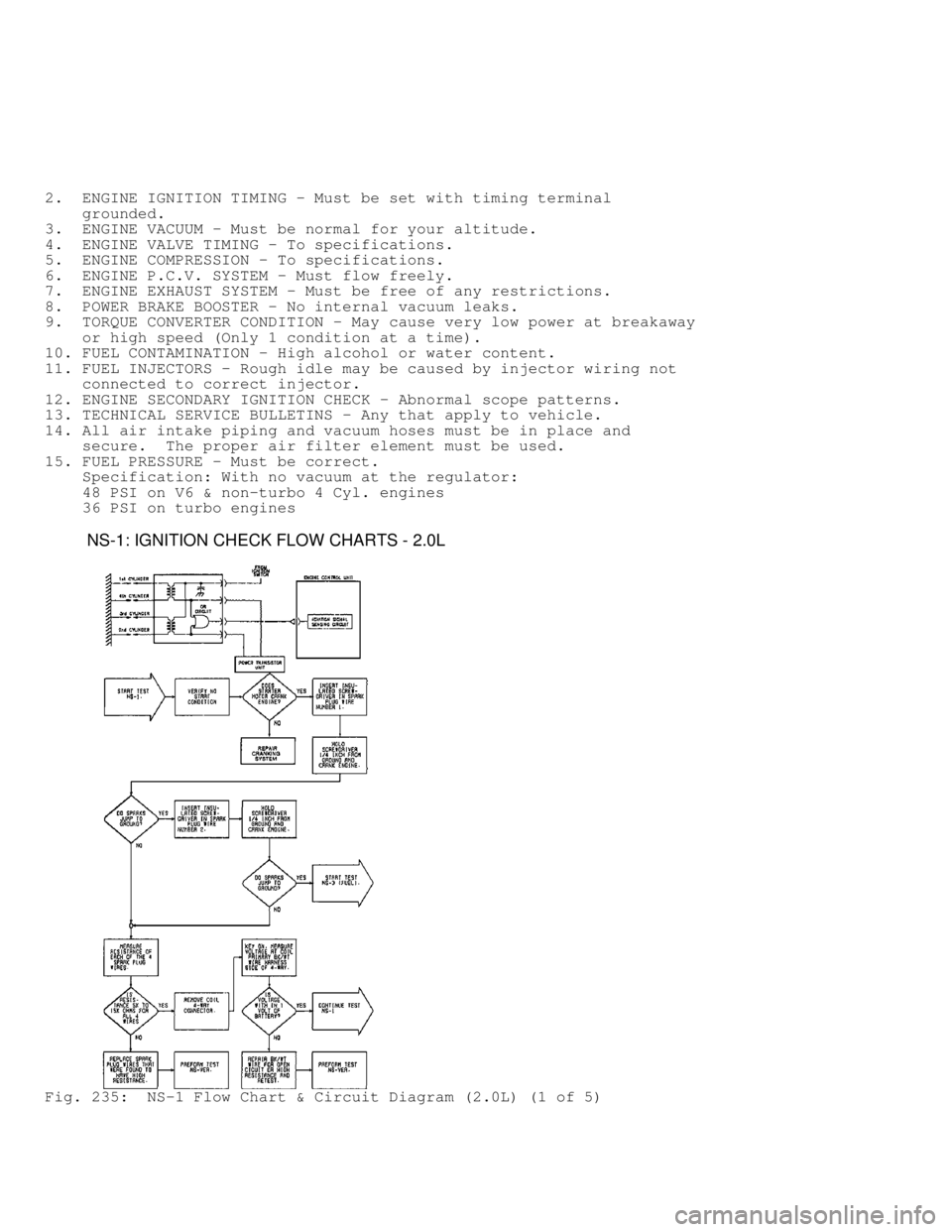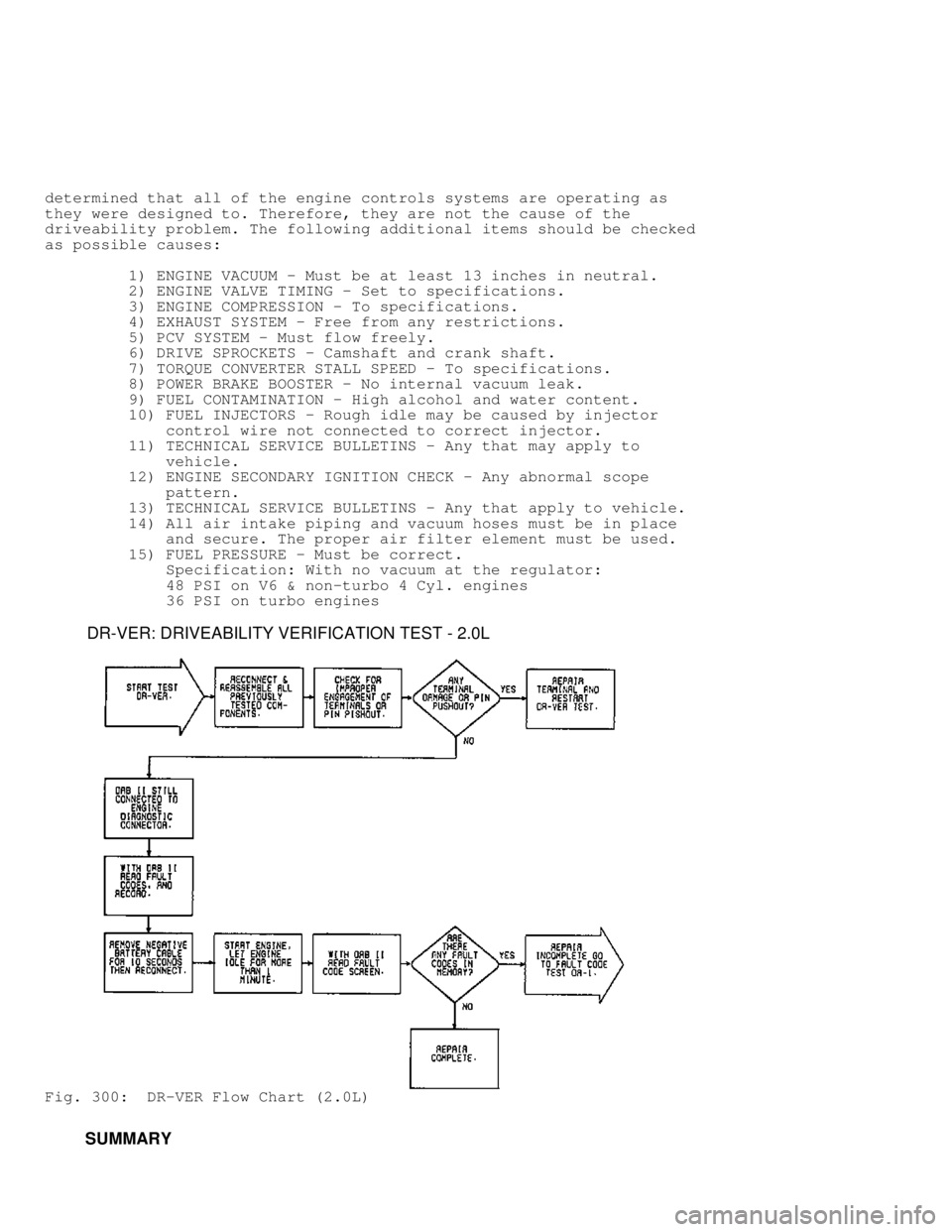Page 937 of 1333

that all of the engine control systems are operating as they were
designed to. Therefore, they are not the cause of the driveability
problem.
The following additional items can not be overlooked as possible
causes of a driveability problem.
1. THROTTLE VALVE AREA - Dirt or ice buildup causing rough idle and
stalling.
2. ENGINE IGNITION TIMING - Must be set with timing terminal
grounded.
3. ENGINE VACUUM - Must be normal for your altitude.
4. ENGINE VALVE TIMING - To specifications.
5. ENGINE COMPRESSION - To specifications.
6. ENGINE P.C.V. SYSTEM - Must flow freely.
7. ENGINE EXHAUST SYSTEM - Must be free of any restrictions.
8. POWER BRAKE BOOSTER - No internal vacuum leaks.
9. TORQUE CONVERTER CONDITION - May cause very low power at breakaway
or high speed (Only 1 condition at a time).
10. FUEL CONTAMINATION - High alcohol or water content.
11. FUEL INJECTORS - Rough idle may be caused by injector wiring not
connected to correct injector.
12. ENGINE SECONDARY IGNITION CHECK - Abnormal scope patterns.
13. TECHNICAL SERVICE BULLETINS - Any that apply to vehicle.
14. All air intake piping and vacuum hoses must be in place and
secure. The proper air filter element must be used.
15. FUEL PRESSURE - Must be correct.
Specification: With no vacuum at the regulator:
48 PSI on V6 & non-turbo 4 Cyl. engines
36 PSI on turbo engines
NS-1: TESTING IGNITION CIRCUIT - 1.6L
Fig. 75: Circuit Diagram NS-1 (1.6L)
Page 1016 of 1333

The following additional items can not be overlooked as
possible causes of a driveability problem.
1. ENGINE IGNITION TIMING - Must be set with timing terminal
grounded.
2. ENGINE VACUUM - Must be normal for your altitude.
3. ENGINE VALVE TIMING - To specifications.
4. ENGINE COMPRESSION - To specifications.
5. ENGINE P.C.V. SYSTEM - Must flow freely.
6. ENGINE EXHAUST SYSTEM - Must be free of any restrictions.
7. POWER BRAKE BOOSTER - No internal vacuum leaks.
8. TORQUE CONVERTER CONDITION - May cause very low power at breakaway
or high speed (Only 1 condition at a time).
9. FUEL CONTAMINATION - High alcohol or water content.
10. FUEL INJECTORS - Rough idle may be caused by injector wiring not
connected to correct injector.
11. ENGINE SECONDARY IGNITION CHECK - Abnormal scope patterns.
12. TECHNICAL SERVICE BULLETINS - Any that apply to vehicle.
13. All air intake piping and vacuum hoses must be in place and
secure. The proper air filter element must be used.
14. FUEL PRESSURE - Must be correct.
Specification: With no vacuum at the regulator:
48 PSI on V6 & non-turbo 4 Cyl. engines
36 PSI on turbo engines
NS-VER: NO START VERIFICATION PROCEDURE - 1.6L
Fig. 168: Flow Chart NS-VER (1.6L)
DR-VER: DRIVEABILITY VERIFICATION PROCEDURE - 1.6L
Page 1071 of 1333

2. ENGINE IGNITION TIMING - Must be set with timing terminal
grounded.
3. ENGINE VACUUM - Must be normal for your altitude.
4. ENGINE VALVE TIMING - To specifications.
5. ENGINE COMPRESSION - To specifications.
6. ENGINE P.C.V. SYSTEM - Must flow freely.
7. ENGINE EXHAUST SYSTEM - Must be free of any restrictions.
8. POWER BRAKE BOOSTER - No internal vacuum leaks.
9. TORQUE CONVERTER CONDITION - May cause very low power at breakaway
or high speed (Only 1 condition at a time).
10. FUEL CONTAMINATION - High alcohol or water content.
11. FUEL INJECTORS - Rough idle may be caused by injector wiring not
connected to correct injector.
12. ENGINE SECONDARY IGNITION CHECK - Abnormal scope patterns.
13. TECHNICAL SERVICE BULLETINS - Any that apply to vehicle.
14. All air intake piping and vacuum hoses must be in place and
secure. The proper air filter element must be used.
15. FUEL PRESSURE - Must be correct.
Specification: With no vacuum at the regulator:
48 PSI on V6 & non-turbo 4 Cyl. engines
36 PSI on turbo engines
NS-1: IGNITION CHECK FLOW CHARTS - 2.0L
Fig. 235: NS-1 Flow Chart & Circuit Diagram (2.0L) (1 of 5)
Page 1136 of 1333

determined that all of the engine controls systems are operating as
they were designed to. Therefore, they are not the cause of the
driveability problem. The following additional items should be checked
as possible causes:
1) ENGINE VACUUM - Must be at least 13 inches in neutral.
2) ENGINE VALVE TIMING - Set to specifications.
3) ENGINE COMPRESSION - To specifications.
4) EXHAUST SYSTEM - Free from any restrictions.
5) PCV SYSTEM - Must flow freely.
6) DRIVE SPROCKETS - Camshaft and crank shaft.
7) TORQUE CONVERTER STALL SPEED - To specifications.
8) POWER BRAKE BOOSTER - No internal vacuum leak.
9) FUEL CONTAMINATION - High alcohol and water content.
10) FUEL INJECTORS - Rough idle may be caused by injector
control wire not connected to correct injector.
11) TECHNICAL SERVICE BULLETINS - Any that may apply to
vehicle.
12) ENGINE SECONDARY IGNITION CHECK - Any abnormal scope
pattern.
13) TECHNICAL SERVICE BULLETINS - Any that apply to vehicle.
14) All air intake piping and vacuum hoses must be in place
and secure. The proper air filter element must be used.
15) FUEL PRESSURE - Must be correct.
Specification: With no vacuum at the regulator:
48 PSI on V6 & non-turbo 4 Cyl. engines
36 PSI on turbo engines
DR-VER: DRIVEABILITY VERIFICATION TEST - 2.0L
Fig. 300: DR-VER Flow Chart (2.0L)
SUMMARY